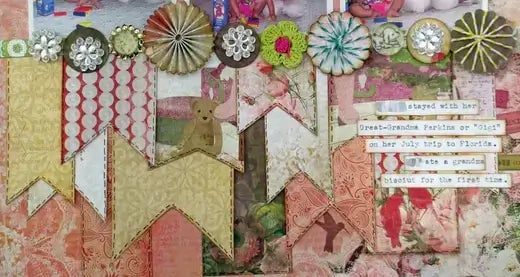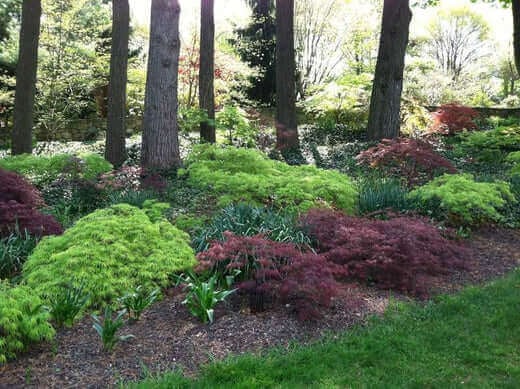TN Nursery's Best Selling Shade Trees
2. Sugar maple
3. Beech tree
Types of Shade Garden Designs
It is this time of the year when we mortals begin seeking a shady spot in our garden for a little reprise from the full blast of the sun. First and foremost, we must all remember that all shade is not created equal. In our garden, we'll find areas of partial shade, deep shade, and light shade - each of these shade garden options is determined by your landscape design.
Deep Shade Garden Design
In a partial shade area, we have a broad range of exciting and colorful plants; yet, these same plants under the heavy shade of an oak or pine will experience difficulty in growing or even surviving. Therefore, a thorough understanding of the type of shade you have and choosing plants for those particular light requirements is the most critical element of a successful shade garden.
Dappled Shade Garden Design
A light canopy of tree foliage produces what is referred to as 'Dappled Shade.' It is a moving pattern of direct sunlight and shade across the ground for 1 or 2 hours a day while receiving bright indirect light all day. Not all trees produce dappled shade; evergreens and trees with dense foliage induce deep shade.
Light Shade Garden Design
From Dappled Shade, we move to Light Shade, also known as open shade, because the area is open to the sky, but walls, hedges, or other structures block direct sunlight. Although there is no direct sun, the affected area still receives plenty of reflected bright light. Many plants thrive in Light Shade, such as vines and climbers to cover stark unattractive walls or privacy fences. It must be noted that the soil tends to be dry in these areas because much of the rainfall is blocked by the structures.
Partial Shade Garden Design
We have covered Deep shade, Dappled shade, and Light shade; where does Partial shade fit in? Partial shade is an area that receives 2 to 6 hours of sun each day. Many of our plants that prefer full sunlight will perform admirably in Partial shade.
Moist Shade Garden Design
Thought we covered all of the shade conditions? Wrong. There is a Moist shade area along streams, ponds, or well-watered flowerbeds. Maidenhair and cinnamon ferns, trillium, bluebells, and forget-me-nots, will thrive in this particular shade condition.
Using Shade in your Landscape Design
Can we control shade? Yes, it is possible to reduce deep shade to dappled shade under trees and large shrubs by pruning. Thinning out branches opens the canopy, permitting more light to reach the ground and increasing the airflow.
First, remove the dead or diseased branches, then prune those that grow toward the center of the tree or shrub rather than outward. Continue selective pruning until you achieve the desired amount of shade. Remember, never prune more than one-third of the branches annually. It is better to remove small branches rather than significant limbs. Removal of the lowest branches will raise the tree's canopy and allow the more direct sun to reach the ground.
The last resort drastic option would be the complete removal of large shrubs and trees, mainly if they are planted too closely together. It may be the only option for trees or shrubs that drop leaves that are toxic to most plants, such as the eucalyptus or black walnut.
Talk to one of our online nursery experts to find out more about how to develop your shade garden design.
Design Patterns for Shade Gardens
Gardeners who wish to build peaceful green spaces will find shade gardens a rewarding design option because these environments flourish under partial to full sunlight conditions. Although certain plant species cannot tolerate shaded environments, some thrive in low-light conditions, including lush ferns, mosses, elegant hostas, and colorful impatiens. Creating an attractive shade garden requires knowledge of the site's microclimate, suitable plant choices, and careful arrangement of elements like texture and color. This section outlines essential factors and design patterns to assist you in developing an attractive shade garden.
The primary step towards successful garden design is a thorough knowledge of the environmental conditions. The most effective way to understand your garden is to study its appearance during various times of day and seasonal changes. Deciduous trees create dappled light, while evergreens and tall fences generate deep shadows. You can choose plants correctly after you understand how much and what shade your garden gets. Astilbes, hostas, and Japanese forest grass stand out for their capacity to thrive in low sunlight conditions, yet each species demands unique moisture levels and soil types.
The concept of layering serves as a fundamental design strategy for shade gardens. The forest floor in a woodland area displays various vegetation tiers, which consist of large trees that make up the canopy above. In contrast, smaller trees, shrubs, and groundcovers occupy the layers below. A layered planting style for your shade garden creates depth and organic structure. Anchor your shade garden with taller shade-tolerant shrubs or small trees at the edges while positioning mid-height plants like hostas and ferns in the center area. Sweet woodruff, lilyturf, and ajuga serve as groundcovers that occupy vacant areas around larger plants and unite the different vegetation layers beneath them.
The strategic use of various textures proves highly effective for shade gardens due to the limited sunlight available. The definition of foliage increases with light filtering through tree canopies, allowing gardeners to create exciting combinations by pairing plants with different leaf shapes and textures. Pair the broad hosta leaves with the delicate maidenhair fern fronds, for example, or juxtapose heuchera's ridged leaves beside the lacy astilbe foliage. Combining different textured surfaces within your garden keeps it from becoming dull and repetitive, even when the weather is cloudy.
Selecting colors for shade gardens requires deliberate planning. Though foliage significantly shapes many shade plant gardens, strategically placing colorful plants can enhance the visual appeal. Impatiens and begonias serve as quintessential shade-flowering plants, while hydrangeas complete this category of plants, and heuchera cultivars display stunning leaf colors from deep burgundy to bright chartreuse. Choose plants with analogous color schemes, such as diverse shades of green and blue, to create a calm and subdued atmosphere when they blend with dappled light. A selection of bright pink, yellow, or white flowers will transform a dark corner into a striking focal point.
Hardscape elements introduce an architectural or modern touch that enhances the design of shade gardens for enthusiasts of contemporary aesthetics. Stone walkways, small water features, or strategically positioned benches establish focal points that direct visual attention and offer practical walking and resting spaces. Consider materials that complement the subdued quality of a shaded area: Natural stone, timber, and brick integrate well with surrounding greenery because they reflect only minimal glare.
Shade gardens require maintenance approaches that vary slightly from those used in sunny gardens. The accumulation of leaves from above requires regular cleanup so that underlying plants won't be smothered. Shade plants require steady moisture levels, which drip irrigation or soaker hoses provide to keep the soil hydrated properly without causing excess water to build up. Organic mulch, like bark or leaf mold, excels in shade gardens because it helps maintain moisture levels while preventing weed growth and improving soil quality.
Designing a shade garden requires considering the space as a unified tapestry instead of separate plant groupings. You can create smooth transitions between garden sections using the same type of plants or similar foliage textures. Spread your favorite hosta with variegated leaves throughout the garden at even intervals to achieve a cohesive appearance. The consistent use of this motif combines the garden elements to achieve a refined and cohesive appearance. Adding unique specimen plants, such as a dramatic Japanese maple or a showy hellebore, creates focal points that guide visitors further into the garden.
The atmosphere of shade gardens frequently conveys feelings of tranquility and enigma. Natural curves and meandering paths enhance this effect to emphasize the garden's path design. Rectangular borders and hard lines appear unnatural in wooded or secluded environments. Meandering borders and natural materials like mossy stones and rustic wood bring shade gardens' organic feel and calming nature to life.
A successful shade garden design relies on understanding site lighting conditions while choosing plants that showcase texture and shape, along with strategic color and hardscape placement for visual appeal. A dark, neglected area becomes a peaceful retreat through layered plant heights, textured foliage, and focal points that enhance your plant palette. The enchanting interplay of dappled sunlight and soft shadows reveals how shade gardens become captivating sanctuaries for plants and people.
Read more

Ferns Make Excellent Border Plants Landscaping in a yard not only makes your house look beautiful and raises your curb appeal, but it also increases the worth of your home. Proper plant and foliage...

Did you know that scrapbooking has taken the world by storm, and so many people are doing it? Moms are getting together with study groups and friends to create groups to scrapbook; churches have sc...


